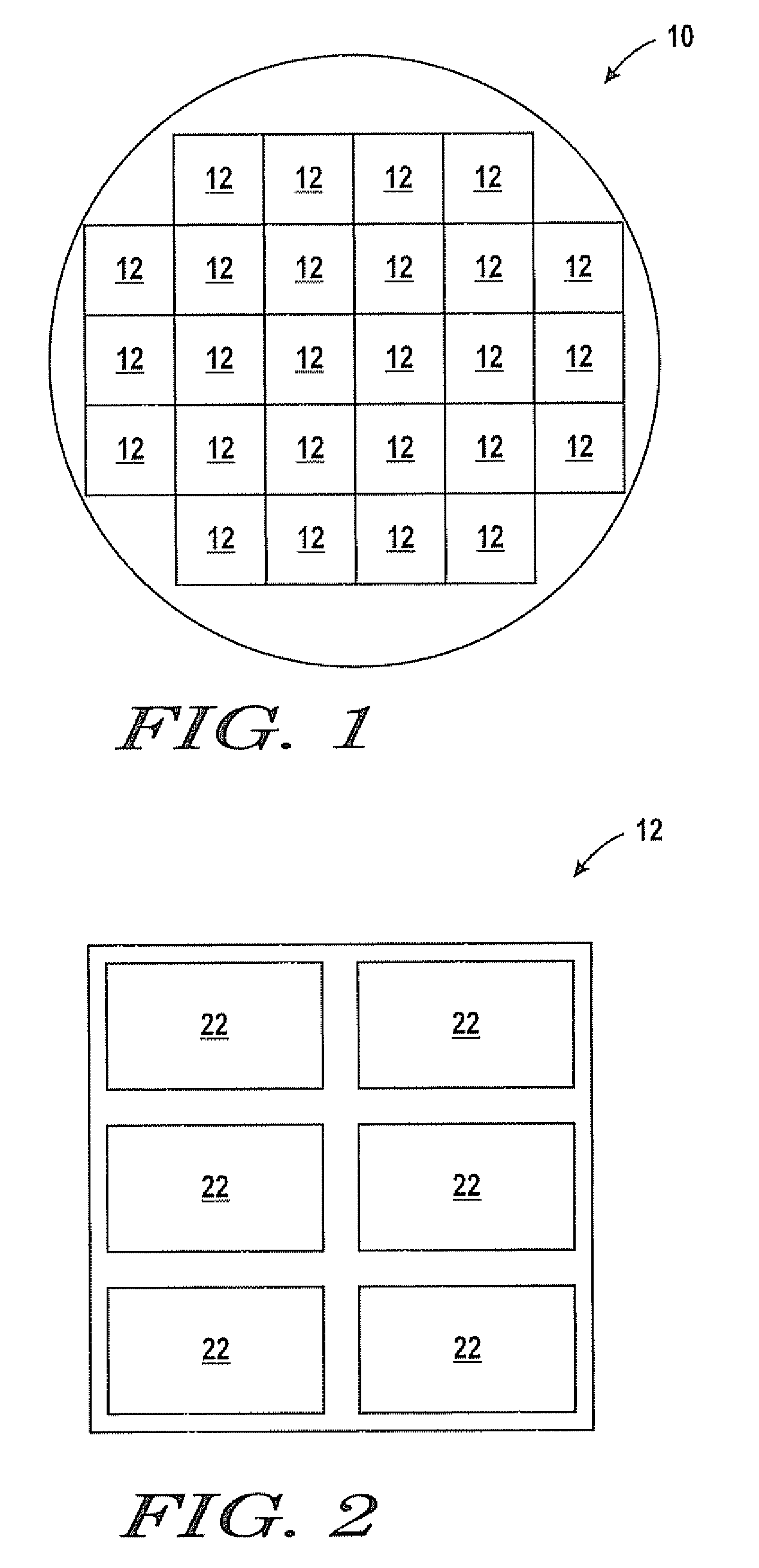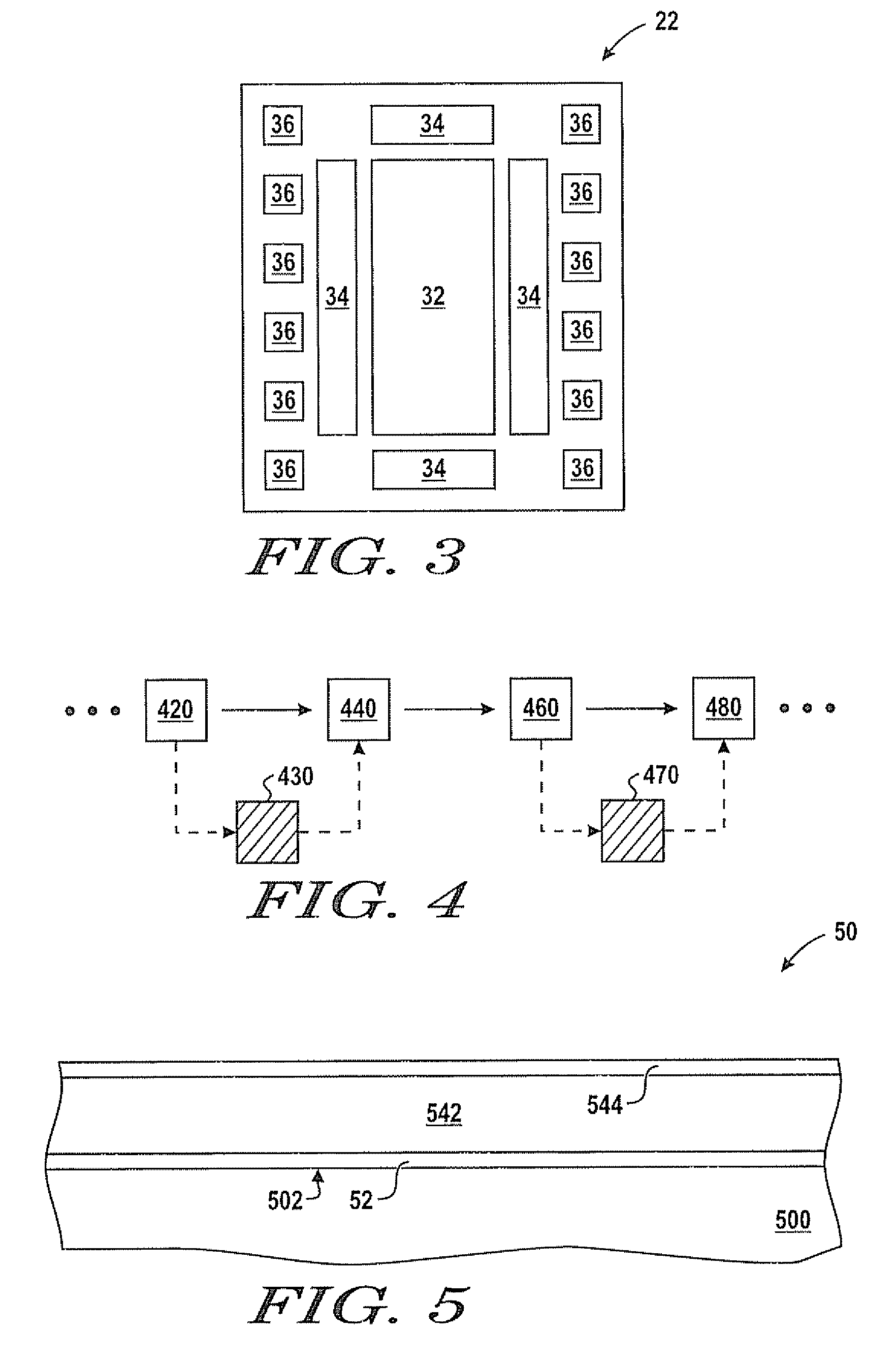Process of fabricating a workpiece using a test mask
a technology of workpieces and masks, applied in the direction of measurement devices, semiconductor/solid-state device testing/measurement, instruments, etc., can solve the problems of no flexibility in changing the sample size (i.e., number of dedicated test structures) without changing the product, and the test workpiece may not yield accurate information regarding the integration of the process
- Summary
- Abstract
- Description
- Claims
- Application Information
AI Technical Summary
Problems solved by technology
Method used
Image
Examples
example 1
[0051]Example 1 demonstrates how the concepts as described above can be used with respect to forming and testing conductive lines, such as word lines within a memory sector, without any need of bond or test pads on the product die. While many details are provided with respect to materials, thicknesses, and formation techniques, such details are merely illustrative and not meant to limit the scope of the present invention.
[0052]Attention is now directed to a process of fabricating a product workpiece. FIG. 5 includes an illustration of a cross-sectional view of a portion of a product workpiece 50 that includes a substrate 500 and layers formed thereon. The portion of the product workpiece 50, as illustrated in FIG. 5, includes part of a partially fabricated product die. The substrate 500 can include a monocrystalline semiconductor wafer, a semiconductor-on-insulator wafer, a flat panel display (e.g., a silicon layer over a glass plate), or other substrate used to form electronic devi...
example 2
[0076]Example 2 demonstrates how the concepts as described herein can be extended to other stacks that define openings having aspect ratios that are even larger than the embodiments as described with respect to Example 1.
[0077]FIG. 14 includes an illustration of a portion of a workpiece that includes a substrate 1400, a dielectric layer 1422, a patterned conductive layer 1442, another patterned conductive layer 1444, and a mask layer 1462. Such a structure may be formed as part of an integrated circuit having different work functions for n-channel and p-channel transistors. For example, the patterned conductive layer 1442 may be designed to achieve a particular work function, and the other patterned conductive layer 1444 may be a conductive strapping layer, such as doped polysilicon. With more layers, the openings between the features as illustrated in FIG. 14 are deeper, and thus, the aspect ratio of the openings is larger. Defects 1482 and 1484 lie along the bottoms of the opening...
example 3
[0080]Example 3 demonstrates how the concepts as described herein can be extended to surface topologies that may hide a defect, such it may not be seen from a top view of a workpiece.
[0081]FIGS. 16 to 19 include illustrations at a point in processing similar to the embodiment as described with respect to FIG. 9. Unlike the embodiment illustrated in FIG. 9, a feature has an overhanging portion that can make detection of a defect by optical methods nearly impossible.
[0082]Referring to FIGS. 16 and 17, a dielectric layer 1622 and a patterned insulating layer 1624 overlie a substrate 1600. Word lines 1642 and 1644 are similar to word lines 92 and 94. Word lines 1644 have been severed to define gaps 1646 between flared portions 1648 and 1649. Each of the word lines 1642 and 1644 include a conductive layer 1662 and a hard mask layer 1664. The dielectric layer 1622, the conductive layer 1662 and the hard mask layer 1664 can have any of the films, materials, thicknesses, and formation techn...
PUM
 Login to View More
Login to View More Abstract
Description
Claims
Application Information
 Login to View More
Login to View More - R&D
- Intellectual Property
- Life Sciences
- Materials
- Tech Scout
- Unparalleled Data Quality
- Higher Quality Content
- 60% Fewer Hallucinations
Browse by: Latest US Patents, China's latest patents, Technical Efficacy Thesaurus, Application Domain, Technology Topic, Popular Technical Reports.
© 2025 PatSnap. All rights reserved.Legal|Privacy policy|Modern Slavery Act Transparency Statement|Sitemap|About US| Contact US: help@patsnap.com



